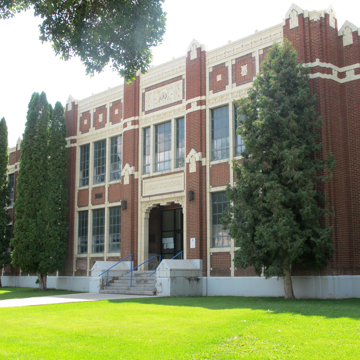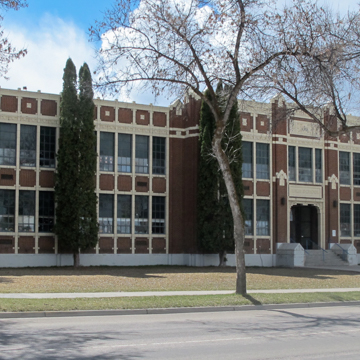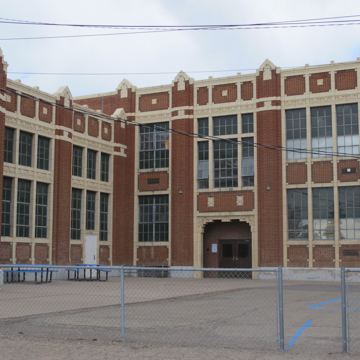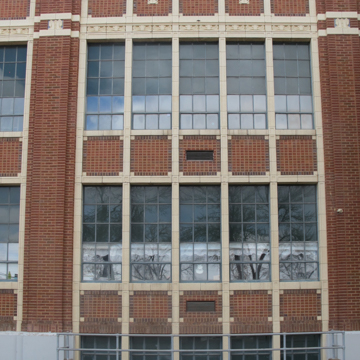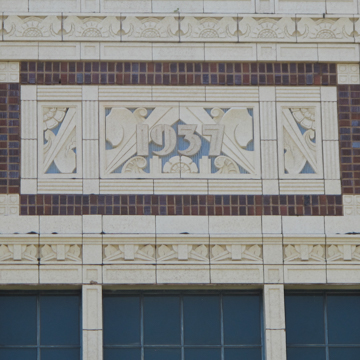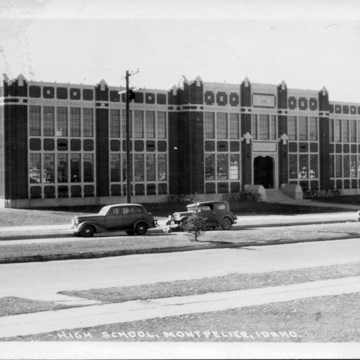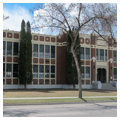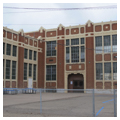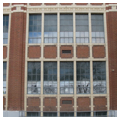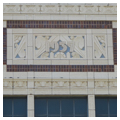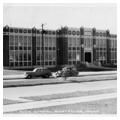You are here
Bear Lake Middle School
The small town of Montpelier, located in the far southeastern corner of Idaho, was discovered in the 1840s by Oregon Trail pioneers and settled twenty years later when sixteen Mormon families came to the valley to begin a new religious life. Brigham Young, leader of the Church of Jesus Christ of Latter-day Saints, visited the town and suggested renaming it in honor of the capital of his home state of Vermont. In 1892, when Montpelier became a stop on the Oregon Short Line Railroad, which connected Portland, Oregon, with Omaha, Nebraska, the small western town thrived, at least until modernization of the railroad led to the closure of many small railroad maintenance stations, like the one in Montpelier.
The city grew to its largest size of 3,000 people in 1920. By then, the town’s original high school (1907) had been built at the center of town where, across the street from city hall (1915) and the LDS Tabernacle (1918), it helped anchor Montpelier’s civic center. Though the population declined into the 1930s, even during the depths of the Great Depression, Montpelier was stable enough to warrant a new high school to replace the 1907 structure.
In 1937, with funds from the Work Progress Administration (WPA), the city built this modern school. WPA projects like this one allowed small communities like Montpelier to enjoy the benefits of design ideas already circulating in the larger region, in this case Art Deco architecture and design. The two-story, red brick and terra-cotta building was designed by Frank Paradice, eastern Idaho’s preeminent early-twentieth-century architect who was based in Pocatello, eighty-five miles northwest of Montpelier. Paradice was known for his classical designs and his skillful terra-cotta ornamentation. All facades of the building have carefully executed terra-cotta surrounds framing large, leaded windows and brick-faced spandrels. The terra-cotta panel above the entry displays typical Art Deco forms, including stylized floral and sun ray motifs, along with the date of construction. The rigorously symmetrical building has a T-plan, with the rear of the school carefully decorated with terra-cotta to match the front.
In 1967, following district reorganization and the construction of a regional high school, the Montpelier High School was repurposed as a middle school. Today, it remains part of the Bear Lake school district. In 2014, during sesquicentennial celebrations across Bear Lake County, locals remembered the construction of the high school as the “one great blessing which came to the people of Montpelier from the Great Depression.”
References
Attebery, Jennifer. Building Idaho, An Architectural History. Moscow: University of Idaho Press, 1991.
Bear Lake Journal, Montpelier, Idaho: Bear Lake County Historical Society, August 2014.
Hibbard, Don, “Montpelier Historic District,” Bear Lake County, Idaho. National Register of Historic Places Inventory-Nomination Form, 1978. National Park Service, U.S. Department of the Interior, Washington, DC.
Writing Credits
If SAH Archipedia has been useful to you, please consider supporting it.
SAH Archipedia tells the story of the United States through its buildings, landscapes, and cities. This freely available resource empowers the public with authoritative knowledge that deepens their understanding and appreciation of the built environment. But the Society of Architectural Historians, which created SAH Archipedia with University of Virginia Press, needs your support to maintain the high-caliber research, writing, photography, cartography, editing, design, and programming that make SAH Archipedia a trusted online resource available to all who value the history of place, heritage tourism, and learning.














